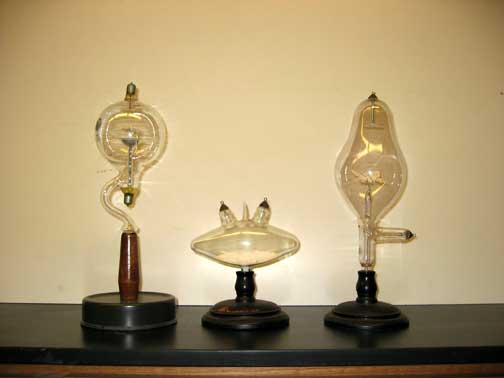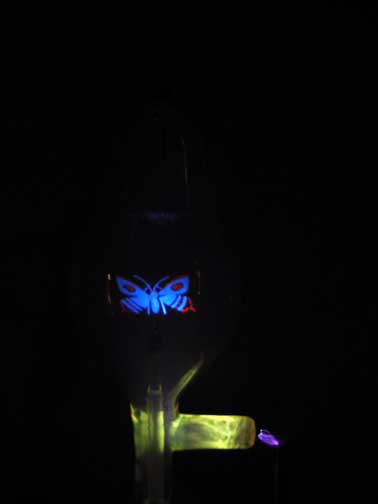The magical force behind electron beams
 Voltage is applied across a vacuum tube creating an invisible beam of "cathode rays" that magically illuminate a fluorescent screen.
Voltage is applied across a vacuum tube creating an invisible beam of "cathode rays" that magically illuminate a fluorescent screen.
Ingredients: cathode ray tubes, voltage source
Procedure: A complete recipe follows.
1. Apply voltage to end of cathode ray tube.
2. Observe glowing screen.
 Understanding:
The mysterious "cathode rays" flowing through the vacuum tubes are now known to be currents of electrons. The electrons are introduced to the vacuum tube by the cathode. The voltage placed across the tube creates an electric field. The charged electrons in the electric field feel a force that causes them to flow from the cathode toward the anode where many are captured. In between, the rays encounter a fluorescent screen, causing it to glow.
Understanding:
The mysterious "cathode rays" flowing through the vacuum tubes are now known to be currents of electrons. The electrons are introduced to the vacuum tube by the cathode. The voltage placed across the tube creates an electric field. The charged electrons in the electric field feel a force that causes them to flow from the cathode toward the anode where many are captured. In between, the rays encounter a fluorescent screen, causing it to glow.
In the cathode ray tube of J.J. Thomson (1856-1940) the electrons were introduced at one end containing the cathode and collected in the middle by a cross-shaped anode. Beyond the anode was a fluorescent screen covered with zinc sulfide. The cathode sprayed out its "rays" and those not absorbed by the anode would illuminate the screen, leaving a shadow of the cross-shaped.
In our cathode ray tube, we run electrons - or cathode rays - through the tube. Within the tube is a butterfly that is painted with fluorescent compounds. The cathode rays that impact the butterfly cause it to fluoresce, just as Thomson's screen was made to fluoresce in his classic experiment.
The force that moves electrons through the vacuum tube is an essential force that mediates all important interactions in chemistry. It is also a force that is exploited in making powerful tools for the exploration of the atomic world, like the mass spectrometer.